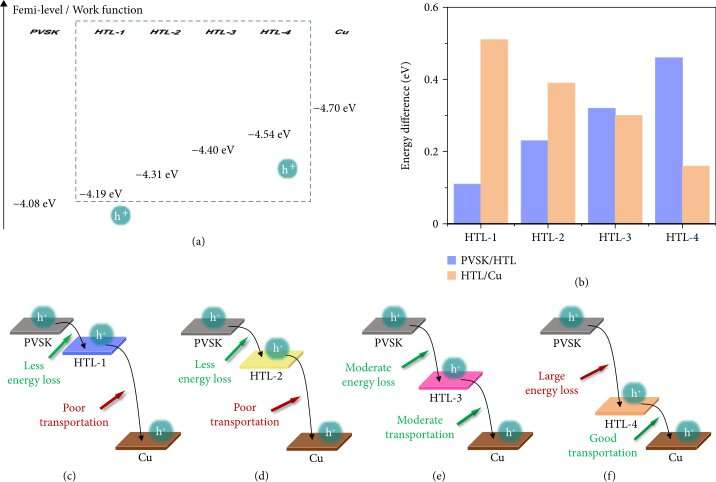Optimizing efficient perovskite photovoltaics

Developing low-cost and stable metal electrodes is crucial for mass production of perovskite solar cells (PSCs). As an earth-abundant element, Cu becomes an alternative candidate to replace noble metal electrodes such as Au and Ag, due to its comparable physiochemical properties with simultaneously good stability and low cost. However, the undesirable band alignment associated with the device architecture impedes the exploration of efficient Cu-based n-i-p PSCs. To solve this problem, researchers in China investigated the energy-level difference at different interfaces and offered a potential path forward to achieve more efficient n-i-p PSCs with a Cu electrode.
They published their work on July 8 in Energy Material Advances.
"The development of cost-effective and high-performance PSCs is imperative," said paper author Huanping Zhou, professor with School of Materials Science and Engineering, Peking University (PKU). "Currently, the Cu electrode has attracted much attention due to its low cost and good stability, but it is limited in the performance for n-i-p structure PSCs."
Zhou explained that the Cu electrode has several significant advantages as an alternative to Au or Ag, especially as the back electrode, which is responsible for carrier transportation in the device.
"Cu is the earth-abundant element, and it costs less than 1/80th that of Ag and 1/5500th that of Au," Zhou said. "Cu is the promising candidate to be PSC electrode for its comparable physical properties (i.e., conductivity) with Au and Ag, and good stability."
But Cu-based n-i-p PSCs cannot exhibit high photovoltaic performance. According to Zhou, the major obstacle is that the Fermi level of hole transport layer (HTL, such as Spiro-OMeTAD, –4.19 eV) is quite different with the work function of Cu (–4.7 eV), which leads to large Schottky barrier at HTL/Cu interface. This phenomenon does not exist in p-i-n PSCs, because the Fermi level of commonly used C60 (electron transport layer) is about –4.5 eV, which is similar with the work function of Cu. This is why Cu-based p-i-n PSCs can exhibit high optoelectronic performance while Cu-based n-i-p PSCs cannot.
To address this problem, Zhou and her team systematically adjusted the Fermi level of HTLs to match the work function of the Cu electrode, so that the energy difference at HTL/Cu interface can be reduced for better carrier transportation. However, the energy difference between perovskite (Fermi level is –4.08 eV) and the Cu electrode is constant, so the smaller energy difference between HTL and Cu means larger energy difference between perovskite and HTL, which is deleterious for carrier extraction. How to balance the energy difference between perovskite/HTL and HTL/Cu interfaces is becoming important for PSC performance.
"Just like the bucket effect, we hope both perovskite/HTL and HTL/Cu interfaces are not the shortest buckets during device operation," Zhou said. "In this paper, we carefully adjusted the Fermi level of HTLs to balance the energy difference at perovskite/HTL and HTL/Cu interfaces, through adding different amount of PTAA into Spiro-OMeTAD."
"We concluded that the balanced energy difference between perovskite/HTL and HTL/Cu interfaces could significantly improve the charge collection and transport properties in the resultant n-i-p PSC devices," Zhou said.
The researchers tested the optoelectronic performance of n-i-p PSCs based on the Cu electrode and different HTLs. Through the photovoltaic parameters, Zhou said, smaller energy difference between HTL and Cu could lead to higher short-circuit current density (Jsc), while smaller energy difference between perovskite and HTL could lead to higher open-circuit voltage (Voc). Finally, the balanced energy difference between perovskite/HTL and HTL/Cu interfaces could lead to moderate Jsc and Voc, especially higher fill factor (FF), which eventually contributed to the improved power conversion efficiency (PCE).
"The best performing n-i-p PSC with the Cu electrode achieved a PCE of 20.10% with the Voc of 1.084 V and FF of 78.77%," Zhou said. "The devices also exhibited good stability, which could remain at 92% of their initial PCE after 1000 h storage. This finding not only extends the understanding on the band alignment of neighboring semiconductor functional layer in the device architecture to improve the resulting performance, but also suggests great potential of the Cu electrode for application in PSCs community."
More information: Ziqi Xu et al, Balancing Energy-Level Difference for Efficient n-i-p Perovskite Solar Cells with Cu Electrode, Energy Material Advances (2022). DOI: 10.34133/2022/9781073
Provided by Beijing Institute of Technology Press Co., Ltd




















